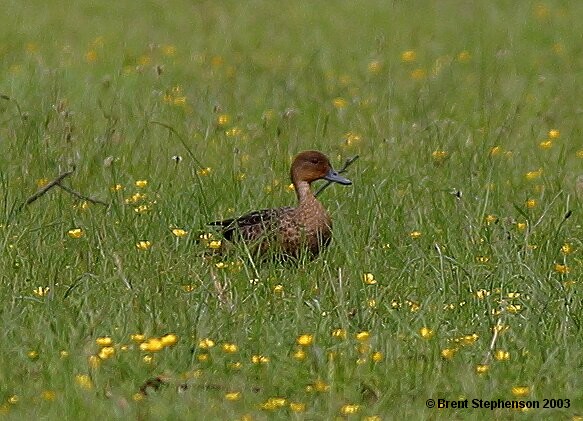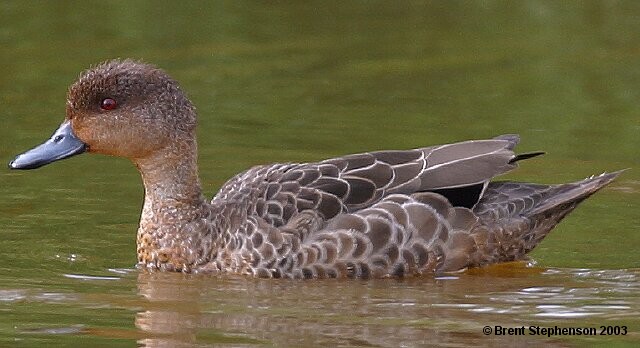Chestnut teal or hybrid?
Initial thoughts – click here for final thoughts
21/11/02 Possible chestnut teal, Anas castanea, breeding in New Zealand!!
Sav received a call from Colin Ogle of Wanganui on the evening of 20/11/02. Colin had just been to see a possible chestnut teal, Anas castanea, that appeared to be breeding on a small farm dam on a property owned by Neil Corballis, near Wanganui. Today (21/11/02) we headed out there and met up with Colin, Nic Peet (from DoC), and the land owner, Neil, and headed to the small farm pond where the bird was located. Neil is familiar with grey teal, Anas gracilis, as they are present on other parts of the property, but thought this darker, more confiding bird was possibly a brown teal, Anas chlorotis. This is the third summer that a similar bird has been seen at the same pond, and it bred there last year.
Upon approaching the dam we saw what looked like a chestnut teal disappear into long grass, with at least three ducklings, about 1/3 grown. The day before the bird had come out into the middle of the pond when the dam was approached, but this afternoon it stuck tight under some rushes. In the end two birds came out into the middle of the dam, and one headed out over the paddocks, whilst the other called and paddled around the dam allowing photos to be taken, before it took flight, to returning a few minutes later.

Above is the first bird that I photographed (the one that then headed over the paddock). It appeared too reddy-brown for a grey teal, with quite reddish cheeks, but also a very puzzling jizz. As can be seen in the above photo, and it is especially apparent in the next two, the bird has a distinctly long neck. This bird is certainly puzzling, and although not a grey teal, we feel it just didn’t fit the bill of a chestnut teal either.
Despite disappearing over the paddock, and remaining 150m or so away, where the next few shots were taken, the bird put on a bit of a display, obviously trying to draw our attention from the ducklings, which were obviously still taking shelter in the long grass on the edge of the pond. As can be seen in the above photo the birds wings are held drooped and the bird was flapping along the surface. We now suspect this bird to be the male….


The next shots are of the second bird that came out of the grass, a surprise to us all as we thought there was only one chestnut ‘type’ duck present. As can be seen from the photos this bird appears far more like a chestnut teal, and had this bird been seen on its own there probably would have been little question as to its identification. We suspect this bird is the female and could be a true chestnut teal? However, the presence of the unusual first bird throws some doubt upon this bird too.


The next few shots are of the above bird in flight, and then relanding back at the pond. Although not particularly good photos they do show the wing pattern and underparts of the bird.


So, we are currently unsure what to think about these ducks. We plan to revisit the site in several weeks, when hopefully the ducklings will be feathered and may show some clues as to their identity.
We strongly suspect that we are dealing with hybrid grey/chestnut teal, and feel the first bird (first three photos) has to be a hybrid, whilst the second fits the bill of a straight chestnut teal more closely. If this is correct then that would make the first bird the male, and the second the female. We tend to rule out brown/grey hybrids from the fact that you might expect darker plumage, and possibly white around the eye. The fact that the second bird fits a chestnut teal, suggests the other is more likely a chestnut/grey hybrid, rather than a brown/grey hybrid also.
This record is especially important due to the fact that if confirmed, this would be the first record of chestnut teal breeding in New Zealand. Also of direct relevance to this sighting are the records of chestnut teal from the nearby Manawatu Estuary – see the 11/05/02 trip report in our Trip Report section. It has been long suggested that chestnut teal could be breeding along this part of the coast, although vagrant birds from Australia are just as likely. At least one chestnut ‘type’ bird has been present at the Manawatu Estuary almost every winter since the early 1990s. The most recent bird seen there in May (photos in the 11/05/02 trip report), was almost certainly a full male chestnut teal. Its plumage was between eclipse and breeding plumage, and appeared to have changed with the head being more glossy, when seen several weeks later.
We would be very happy to hear the opinions of others, and especially welcome input from Australian birders who will of course be far more familiar with chestnut teal than us. Email me here….
All the above photos were taken by myself, using a Canon D60 and 300mm f4 L IS lens. All photos are copyrighted and permission must be given to copy or use the images in any form.